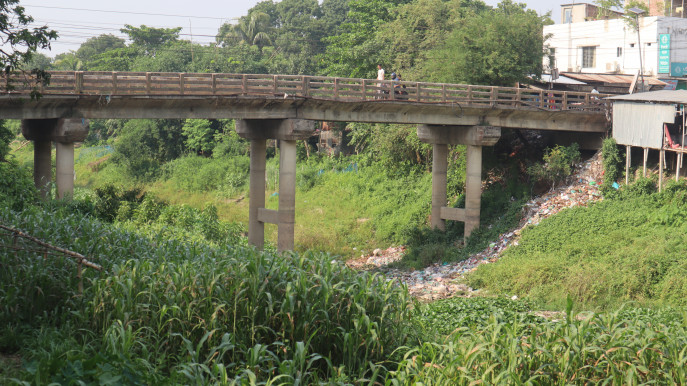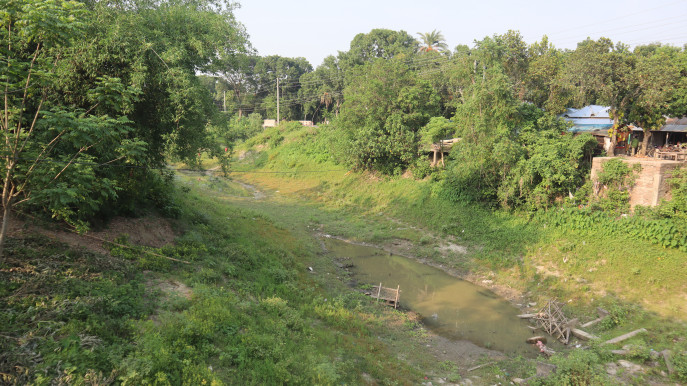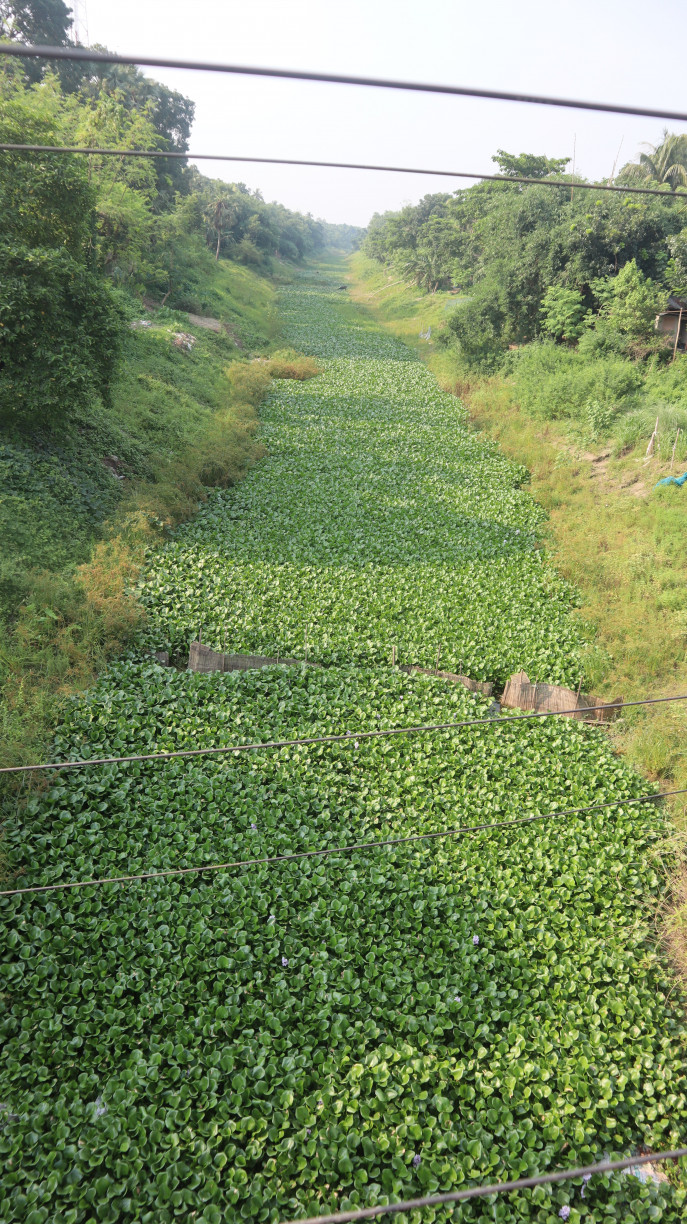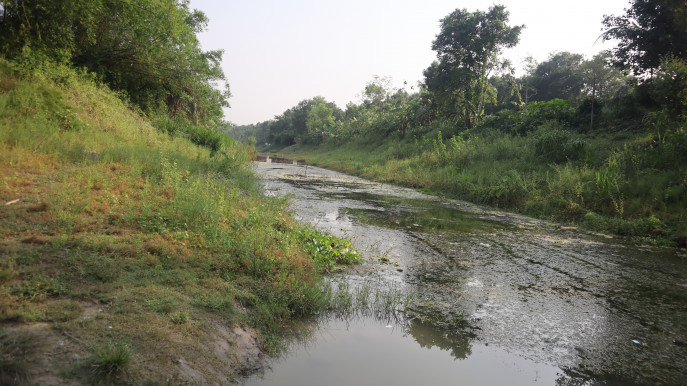A river that was once 40-50 metres wide has narrowed to less than 10 metres in most points, which barely has any water
Faruk, a shopkeeper in Baliakandi Bazar on the bank of Chandana, would not stop talking about the mighty river he had known in his childhood.
“Big boats, launches and trawlers used to sail through it. All our crops were transported on boats back then,” Faruk’s face lit up as he recounted childhood memories of the Chandana River.
One of the largest offshoots of the Padma River, Chandana branches out at the village Dahuka of Pangsha upazila in Rajbari district and flows for about 120 kilometres in Rajbari and Faridpur districts, gets renamed as Barasia at some point, before debouching into the Gorai-Madhumati River.
However, Faruk’s tales of the river took a tragic turn.
“Look what has happened to our river. You can see from under the bridge [in Balikandi Bazar] that the river is dead. It is a canal full of garbage,” Faruk said. “It doesn’t have water for even three months a year. We are riverine people, but now we struggle to squeeze water out even from our tube wells.”
Chandana River barely has any water. In some areas you might find a narrow flow of water, but much of it has dried. We even spotted goats grazing in the now dried up river, where fish was once abundant.
Locals and experts we interviewed said illegal encroachment of the river, its drying up at the source, low bridges, and improper dredging have damaged the Chandana River to the core.

A river that was once 40-50 metres wide has narrowed to less than 10 metres in most points.
Whereas the low flow from the Padma is a natural difficulty, the man-made hazards against the Chandana River has worsened the situation.
Street food vendor Ruhul Sheikh, who sells fuchka and chotpoti on Tetulia Bridge connecting the two banks of the river, said once trawlers sailed from under the banyan tree on the other side of this bridge through the river to Pangsha.
“We could find all sorts of fish including boal in this river. I fished here myself with polo [a type of fishing gear],” Ruhul said. “But there is no water in any part of the river now.”
River specialist Mohammad Azaz, chairman of the River and Delta Research Centre (RDRC), said that this “meandering river” had a navigable connection with the Kumar and Gorai just 40 years ago.
“The 120-kilometre-long Chandana River travels through three districts and has rich biodiversity and ecology,” Azaz said. “But mismanagement of water governance, for example, wrong engineering of embankments in Faridpur and other areas, has cut off many sources, tributary channels, and wetland connections, drying it up,” he said.
“Farakka and insufficient flow of Ganges channel’s water discharge is also one of the major causes of this river’s death,” he added.

‘No water even in wet season’
Aynal Mia, a man in his 60s, was gossiping with his friends at a tea stall by Chandana.
He said that once they had taken a bath in the river in Chaitra month, but now the river does not get water even in Aashar month (wet season).
“Once we even fished in the river during Chaitra month, but now there are no fish. We get water for barely three months in this river. Some common fish can be found then. But they too vanish as the water dries up,” Aynal said.
Aynal, like many in the Chandana bank, believes that the only way to revive this river is by dredging.
“Only dredging could save this river. Also the sluice gates should be well taken care of. There should be a way to preserve the water,” he added.
‘Wrong’ dredging, wrong bridges
Aynal’s friend Hasan Ali, however, strongly differed on the prospect of dredging.
This river was dredged several years ago under the Chandana-Barasia river dredging project implemented by the water resources ministry.
But Hasan Ali, and many others like him, believed the dredging did more harm to the river than good.
“We had at least a little water before they dredged the river. While dredging, they did not take out the soil, rather kept it on the edges of the spots they had dug up. As a result, when water came, it washed the soil back to the river, and filled up some of the naturally deeper spots along the way,” Hasan said.

“There used to be places where we had water in Chaitra-Baishakh months, but the loose soil filled those up and killed the river,” he added.
Among others, the suspicion of wrongdoings with the dredging is shared by Rajbari-based historian, journalist and activist Babu Mollick.
“We found the water flow very low soon after it was dredged. If it was dredged properly, the situation could have been different,” he said.
Mollick also blamed the low and small bridges on Chandana River as a factor for narrowing the river.
“Decades ago, I led a bridge construction project on this river. The administration allocated a budget identifying the width as 30 metres. But when I went to survey it, I found it to be 50 metres. I worked on it and revised the budget for a 50-metre bridge,” he said.
But maintaining river integrity was not a priority while constructing most of the bridges and workers instead filled up parts of the bank while building those. That sped up the process of river encroachment.
When reached out for queries, district Water Development Board officials did not respond to calls.
Encroachment and pollution go hand in hand
Sanjeeb Kumar Das has lived his entire life on the banks of Chandana River.
His mind is fresh with the memories of Chandana’s “tasty” fish like Koi, Tengra and Sorputi. But what drives him mad about the death of this river is the extinction of the Rayek fish.
“Chandana’s Rayek was unmatched,” Sanjeeb claimed.
He has been reporting on the pollution and encroachment of Chandana for decades.
“Look at this waste under the bridge,” he said. “The authorities raised a sign asking people to not pollute the river after we reported it, but that is all. This part is a garbage canal now.”
Besides pollution, encroachment is an epidemic for the entire Chandana bank.
“All these infrastructures that you see have been built by encroachment,” Sanjeeb said, referring to the stores in Baliakandi Bazar built on both sides of the river.
Babu Mollick said the lands where the river crossed in bazar areas have become costly. As a result, land-grabbing and encroachment has become unstoppable.

Considering the river’s blessing for both sides of the bank’s agriculture, Bangabandhu took on the Chandana-Barasia project back in the day.
“This is one of the largest hubs for jute and onion. This river should have been saved,” he added.
The Chandana-Barasia’s revival, however, had a real shot if the Ganges Barrage Project in Pangsha, a much hyped project of the last decade, had come true. Officials said the project would see an increased water flow through the Chandana-Barasia, Hisna-Mathabhanga and Gorai-Modhumati systems.
But that project was dropped in 2017.
The people who long advocated for Chandana River, the likes of Babu Mollick and Sanjeeb Kumar, have almost lost hopes of saving it.
Not beyond saving
But Mohammad Azaz said that it is still possible to save the river.
“There should be a comprehensive survey so that sustainable dredging can be done to ensure water flow,” Azaz said.
“The municipality authorities must stop waste dumping now and the district commissioner must take eviction drives as soon as possible,” he added.
Besides setting up the demarcation pillars, Azaz said dredging is necessary at the source of this river to ensure that water is transported to this channel properly.
“No surveys have been undertaken yet to conserve this river. We also found local government authorities, the Water Development Board and Department of Environment are very reluctant to prevent this ecological loss,” he added.
News Link: Chandana: The death of a once mighty offshoot of Padma | The Business Standard (tbsnews.net)
